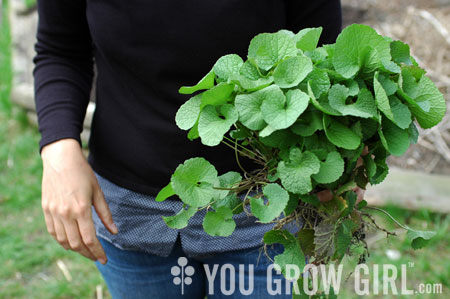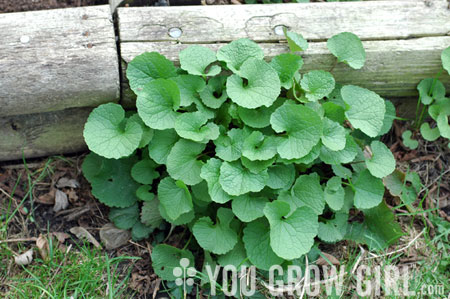
The garlic mustard population is really getting out-of-hand at the community garden this year. I’ve discovered loads of it in unused areas of disturbed, lousy soil and it is expanding rapidly into the edges around plot beds. I was diligent in removing much of it last year so the population isn’t big enough yet to really get under my skin, but this plant is so prolific, and such an evil overlord taking over wherever it sets roots that I’m going to have to get at it with due diligence to avoid disaster next year.
For those who’ve had the good fortune of avoiding it, garlic mustard is an extremely invasive, biennial plant that was probably brought to North America by European settlers, most likely to be cultivated for food and medicine. And I can see why. It’s delicious stuff and the herb books are filed with useful garlic mustard-based remedies. The plant also over-winters nicely under snow, even in my region, which for settlers probably meant something green in the cold months. Unfortunately the plant got loose and has since become a bit of a botanical menace, encroaching on native woodland plants in many parts of the Eastern United States and southern parts of Ontario, Canada (where I live). In fact it’s become such a pain that local communities are starting to band together on special garlic mustard eradication days, going out into woodland areas in groups with the sole purpose of removing the plant.
But like I said, there is a bright side to this — we can use our mouths and stomachs to help keep this bad ass botanical in check. The leaves have a strong garlic flavor and the roots have a bit of a kick making them a good substitute for horseradish (incidentally also a menace). When pockets of it started to turn up in my own gardens last year I figured I might as well figure out some use for it while going through the pains of pulling it out. We’ve tried a few recipes but I am finding that I am as sensitive to this plant as I am to garlic itself. We’ve enjoyed it, but in much smaller quantities than are harvested. The other key to use that I have found is to mix it up with other ingredients. This tempers the bitterness, and in my case prevents digestive upset.

While the leaves are bitter, young leaves can be eaten fresh in salads if you remember to harvest in the early spring. The plant is generally tastier BEFORE the flowers and seeds appear which is a good thing because it’s advised to get them out of the ground before the seeds have a chance to spread. It can also be sautéed or wilted like spinach. The garlic flavor goes nicely with butter. And mushrooms. Maybe with a pinch of salt and a splash of lemon. Yum. Pesto is a popular use since the bitter garlic flavor works nicely on pasta, no additional garlic required. Making pesto is also a good way to use up and store the plant for long term use. Just package it up and keep it in the freezer. Don’t worry about running out, for better or worse there will be plenty more next year.
Related:
- Garlic Mustard Recipes
- Eat it to Beat It – An interesting article on the recent spread of the plant and how it produces chemicals in the soil that push out other plants.
- “Identifying and Harvesting Edible and Medicinal Plants in Wild (and Not So Wild) Places” by Steve Brill
- Stinging Nettle Soup
- Weeds in Your Garden — Bite Back!
- Herbal Vinegars
- Delicious Dandelion
- Dandelion Hortopita
The “weed” growing in the trash can alley for my condo complex is actually claytonia. It grows next to my garbage and you can eat it? (with adequate washing, of course) Plants are so neat.
I don’t know how feaseable this would be for you- but have you considered drying it and bottling it up? You could even sell it in your store. I’d buy a bottle from you. Sounds delicious.
that really looks a lot like the common violet… but no flowers? i thought garlic mustard was tall with reddish orange flowers.
Wow, what a great post! Garlic mustard is one of the scourges of my part of Pennsylvania. Normally, I feed weeds to the chickens, but I don’t want a bunch of garlic-flavored eggs, so i’ve just been composting it. maybe I’ll try cooking up a batch of garlic mustard pesto, or at least adding some leaves and roots to salad and seeing how it tastes. Thanks for the great suggestions!
Wow, what a great post! Garlic mustard is one of the scourges of my part of Pennsylvania. Normally, I feed weeds to the chickens, but I don’t want a bunch of garlic-flavored eggs, so I’ve just been composting it. Maybe I’ll try cooking up a batch of garlic mustard pesto, or at least adding some leaves and roots to salad and seeing how it tastes. Thanks for the great suggestions!
Lisa: It’s garlic mustard before the flowers have developed. The other important thing to note when identifying is that this plant is a biennial. The first and second year plants look different. The first year is much smaller and lower to the ground and the second year grows much more columnar. And you can’t miss the garlic smell.
My town recently had its second annual Garlic Mustard Festival, which includes education, activities, recipe sharing and a work session to get rid of it. I think it’s a great solution.
http://dailyherald.com/story/print/?id=174771
RE: invasive weeds
If there is one enviro-friendly solution to invasive weeds it is this:
REPETITIVE APPLICATION OF BOILING WATER
;)
(TRUST ME!)
I don’t know that I’ve noticed any of that around where I live.
My parents do have a horseradish patch. They dig out bunches every year because it is so prolific. I have not noticed it spreading around the neighborhood. Menace or no, horseradish is tasty stuff!
I am currently on a chive “purge”. That spreads like crazy in my garden and yard, and we can only eat so many salads, potatoes, and eggs with chives! I agree with the boiling water trick- I use that on my patio to kill anything between the pavers- works really well!
i just recently learned about garlic mustard and am so glad to learn that it can be used in cooking and salads! every time i go out to my garden, i pull out as much as i can from the woods nearby. there is still a ton, but pulling this weed has been quite therapeutic and satisfying, now it can be nourishing as well! thanks for the info!!
hi gayla,
question – is it safe to use commercial, non-organic fertilizer on my vegetable seedlings (that i want to eat eventually) or should i be using something else?
thanks!
It just goes crazy this time of year around here. One day you head in to work and you notice that there are white flowers on 3′ tall stalks EVERYWHERE that isn’t mowed.
We also have wild mustard, the variety with the yellow flowers, too.
They used to sponsor “Garlic Mustard Pulls” every spring, but I think they got disenhearted and gave up.
i was pulling garlic mustard along a trail a week ago and got busted by another trail walker who thought i was gathering flowers! citizen’s arrest!
I spent at least 8 hours in the past few days pulling this plant out of a garden plot in front of my co-op apartment (this and comfrey which has gone bezerk in our courtyard … now that is a menacing weed as well)! No one has tended to this plot in years and so I decided to bring it back to life. Oh my! Garlic Mustard everywhere (and snails … lots of snails … and a slug … gross) Funny though … as I was doing battle I got a lot of comments from my fellow Bain dwellers telling me it was edible and medicinal and that I shouldn’t pull it up! Hah! I left a small patch which I will harvest regularly but as far as I am concerned garlic mustard and I are at war in that plot and I will win!
tammigail: Just pull it up. You will see more next year… believe me. p.s. Comfrey is also useful! Makes a great fertilizer for your plants.
Gayla Trail you rule the school! We have so much comfry in our courtyard at the Co-op … and now I have a use for some of it! Thanks!
should i post my q in the forum?
Yvette: I didn’t answer your question because it was off-topic for this article. If I answer this way things get too confusing making it hard for others to find the answers down the road.
I also need to state for the record that I can’t answer every question that comes through whether posted in this section or emailed privately. I try to answer as many as I can but to be honest I get so many questions it would be impossible for me to answer them all… especially given that I also need to set aside time in each day to earn a living and pay my rent!
That’s why I recommend that people post urgent questions to the forums… lots of voices who sometimes have much quicker answers!
I have a similar looking plant in my front yard and I’m wondering if anyone can identify it…
The leaves look very much like those pictured above, but are smaller. The root system of of my mystery plant is like clover (it spreads laterally, creating a network close to the ground’s surface). It flowers later in the spring/summer (pink? small flowers in little clusters). The plants smells a bit minty. I just spent an hour pulling a huge amount out of my yard. It’s smothering everything it can.
Any guesses?
Hm… okay on more research it might be ground ivy?
no worries, that makes sense! i will try the forums. keep up the good work.
Have just come across your site and love it to bits … full of stuff that I’m passionate about. I live a very long way from you – at the most southern tip of Africa, but growing tips and shared experiences are welcome in every form. I think I have this garlic mustard cropping up all over my lei-water (a way of watering the whole villiage that goes back hundreds of years) which would explain why it gets into woodlands. However, to be sure its the same plant, could you post a picture of the flowers to help me make a definite identification?
Many thanks
Here’s a picture of it flowering.
It sounds so tasty, but I guess I should be glad I haven’t seen any growing around where I live.
Garlic mustard is a nasty little thing… Even if you like the taste of it, I’d encourage everyone to just pick it all. Don’t leave any for next year – the seeds are so small and so prolific it’s very likely they’ll end up yards away from where they are now. That’s how the problem spreads, actually choking out native vegetation. Worse yet, the seeds can be viable for 7 years! So if you let a plant go to seed this year, expect to be pulling up its descendents for 7 years.
My Master Gardener teacher couldn’t emphasize enough how bad a threat garlic mustard is to native habitat.
Eat it, but don’t leave it! :)